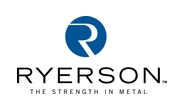Steel Mills

Lehner: No Doom and Gloom on HRC Pricing
Written by Sandy Williams
May 2, 2019
Note: this article was corrected on 5/3/2019; scrap will be down by $20-$30 per ton-in May, not falling to $230 per ton as previously stated.
Ryerson Holding Corp. is expecting a better second half for the steel industry despite some weakening economic data and inventory issues.
“Last year was a very unusual time for our industry. At this time there was a lot of uncertainty about tariffs, in terms of what countries, how much those tariffs would be, would it lead to quotas. No doubt there was some pre-buying going on as people tried to put themselves in inventory position,” said Kevin Richardson, president, South-East region, during Ryerson’s Q2 2019 earnings call. “Enter this year–supply chains have settled, prices are falling and there is some de-stocking–so I think it is going to take some time to settle out.”
Ryerson President and CEO Eddie Lehner added, “Right now we are synching with the overall data, which shows PMI coming down a little bit, industrial production coming down a little bit. There are really two schools of thought at this point. One is that it’s a gradual reset–through the year prices fall, demand is stable and maybe the second half is down a couple of points. But we think it is the other one. We think this is a pause in Q2, an inventory hangover that works itself out. Our base case is that the second half of the year could see a nice recovery.”
When asked to discuss the weakness in hot rolled prices, Lehner mentioned scrap, higher iron ore prices and new capacity. “If you look at scrap flows, domestic or international, the export market for scrap certainly hasn’t been as strong. Scrap looks like it is going to fall by $20 to $30 per ton in May and hot band will get tugged down with it.
“If you look at the juxtaposition of that internationally with iron ore going up, there is a tension that is developing now where there really isn’t much of an import market for HRC. So, it is really a domestic story for new capacity that has come on line. And some of the bigger users of HRC, whether its construction or oil and gas, those end markets aren’t off to a particularly strong start in the first three or four months of the year. But I think it will pick up.
“We see the floor forming for HRC. We don’t think it has much further to fall. There will be a kind of dead cat oscillation. It looks to rebound in Q3, stabilize and move a little bit higher. So, we are not doom and gloom on HRC at this point. We think most of the commodities are going to find a range and even move a little bit higher in the second half of the year.”
Q1 2019 Earnings Results
Ryerson Holding Corp. reported first-quarter revenues of $1.23 billion, a 31 percent increase year-over-year. Tons shipped increased by 18 percent to 619,000 tons due to the acquisition of Central Steel & Wire. Excluding CS&W, revenue was $1.06 billion with shipments declining 0.6 percent year-over-year. CS&W posted net sales of $172.2 million.
Net income for the quarter was $29.5 million, up from $10.4 million in Q1 2018.
Average selling price per ton was $1,988 compared to $2,010 in the fourth quarter. Inventory stood at 75 days of supply compared to 82 days in the fourth quarter and was in Ryerson’s target range of 70 to 75 days.
Looking ahead, Ryerson expects customer demand to be stable in the second quarter. Shipments are expected to be flat in the second quarter compared to the first, with continued destocking of customer inventory and short mill lead times. Weaker commodity pricing for carbon, aluminum and nickel will result in a 1 to 3 percent decline in average sales pricing. Ryerson anticipates average costs will decline at a slightly faster rate than average selling prices.

Sandy Williams
Read more from Sandy WilliamsLatest in Steel Mills

CRU: Tata Steel looks to shed 1,600 jobs in the Netherlands
The company said, “The challenging demand conditions in Europe driven by geopolitical developments, trade and supply chain disruptions and escalating energy costs have affected the operating costs and financial performance."

Reports: Federal funding for Cliffs’ project could be slashed
Elon Musk's DOGE is determining which Department of Energy grants to advance and which ones to terminate, according to several media outlets

Trump still against selling USS to Japanese firm: Report
Despite ordering a new review of Nippon Steel’s bid for U.S. Steel, President Trump said he is still against selling USS to a Japanese company, according to media reports.

Algoma looks to sell more steel in Canada in wake of Trump’s tariffs
The Canadian steelmaker said its absorbing higher tariffs as it moves forward.

Ancora abandons plan to take over leadership of USS
Investment firm Ancora Holdings Group has halted its play for U.S. Steel's board, citing Nippon Steel’s proposed bid for USS “gaining momentum.”
